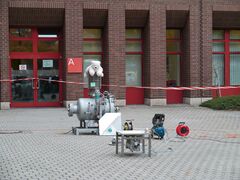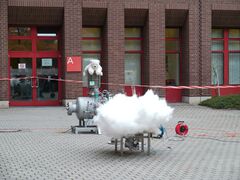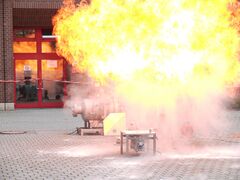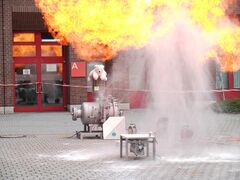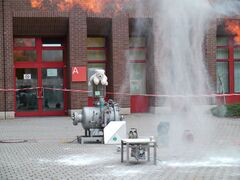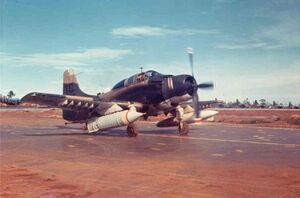قنبلة فراغية
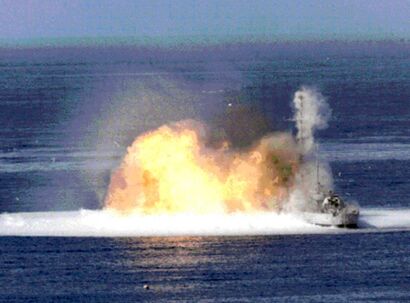
القنبلة الفراغية (thermobaric weapon، aerosol bomb، vacuum bomb)،[1] هو نوع من الذخيرة المتفجرة التي تعمل عن طريق تفريق سحابة رذاذ من الغاز أو السائل أو المسحوق المتفجر.[2][3] تتكون الأسلحة الحرارية من الوقود بنسبة 100% تقريبًا، ونتيجة لذلك فهي أكثر قوة بكثير من المتفجرات التقليدية ذات الوزن المكافئ.[4] غالبًا ما يكون الوقود عنصريًا.[5] يمكن تركيب العديد من أنواع الأسلحة الحرارية على قاذفات محمولة باليد،[6][7] ويمكن كذلك إطلاقها من على الطائرات.
الآلية
- انفجار الغبار الحراري في الهواء الطلق
يتم نثر الدقيق المطحون جيدًا.
ليس هناك ما يشعل التسخين المشع الشديد هنا.
تتكون معظم المتفجرات التقليدية من وقود–مؤكسد، لكن الأسلحة الحرارية تتكون فقط من الوقود ونتيجة لذلك فهي أكثر قوة بكثير من المتفجرات التقليدية ذات الوزن المكافئ.[4] إن اعتمادها على الأكسجين الموجود في الغلاف الجوي يجعلها غير مناسبة للاستخدام تحت الماء، وعلى ارتفاعات عالية، وفي الأحوال الجوية السيئة. ومع ذلك، فهي أكثر فعالية إلى حد كبير عند استخدامها في الأماكن المغلقة مثل الأنفاق والمباني والتحصينات الميدانية المغلقة بشكل غير محكم.[8][9]
تنفجر الشحنة المتفجرة الأولية عندما تصيب هدفها، وتفتح الحاوية وينتشر خليط الوقود على شكل سحابة.[10] تستمر موجة الانفجار النموذجية للسلاح الحراري لفترة أطول بكثير من المتفجرات التقليدية.
على النقيض من المتفجرات التي تستخدم الأكسدة في منطقة محصورة لإنتاج جبهة انفجارية تنبعث من مصدر واحد، تتسارع جبهة اللهب الحرارية إلى حجم كبير، مما ينتج عنه جبهات ضغط داخل خليط الوقود. والأكسدة ومن ثم أيضًا في الهواء المحيط.[11]
تطبق المتفجرات الحرارية المبادئ الأساسية للانفجارات العرضية لسحابة البخار غير المحصورة، والتي تشمل تلك الناتجة عن تشتت الغبار والقطرات القابلة للاشتعال.[12] حدثت مثل هذه الانفجارات الغبارية في أغلب الأحيان في مطاحن الدقيق وحاويات تخزينها، ولاحقًا في مناجم الفحم، قبل القرن العشرين. تحدث انفجارات سحابة البخار العرضية غير المحصورة الآن في أغلب الأحيان في ناقلات النفط وخزانات المصافي والسفن الفارغة جزئيًا أو كليًا، مثل حريق بونسفيلد في المملكة المتحدة عام 2005، حيث أيقظت موجة الانفجار السكان على بعد 150 كيلومترًا من مركزها.
يتكون السلاح النموذجي من حاوية معبأة بمادة وقود، وفي وسطها "شحنة مبعثرة" صغيرة متفجرة تقليدية. يتم اختيار الوقود على أساس طاردة الحرارة لأكسدته، بدءًا من مسحوق المعادن، مثل الألومنيوم أو المغنيسيوم، إلى المواد العضوية، ربما مع مؤكسد جزئي مستقل بذاته.[13] The most recent development involves the use of nanofuels.[14][15]
يعتمد العائد الفعال للقنبلة الحرارية على مجموعة من العوامل مثل مدى انتشار الوقود، ومدى سرعة اختلاطه مع الغلاف الجوي المحيط وبدء تشغيل المشعل وموقعه بالنسبة لحاوية الوقود. في بعض التصميمات، تسمح صناديق الذخائر القوية باحتواء ضغط الانفجار لفترة كافية لتسخين الوقود أعلى بكثير من درجة حرارة الاشتعال الذاتي، بحيث أنه بمجرد انفجار الحاوية، يشتعل الوقود شديد السخونة تلقائيًا بشكل تدريجي عند ملامسته للأكسجين الجوي.[16] تنطبق حدود القابلية للاشتعال التقليدية العلوية والسفلية على هذه الأسلحة. عند الاقتراب، يكون للانفجار الناتج عن شحنة التشتت، وضغط وتسخين الجو المحيط، بعض التأثير على الحد الأدنى. وقد ثبت أن الحد الأعلى يؤثر بقوة على اشتعال الضباب فوق برك النفط.[17] يمكن التخلص من هذا الضعف من خلال التصميمات التي يتم فيها تسخين الوقود أعلى بكثير من درجة حرارة الاشتعال بحيث يؤدي تبريده أثناء تشتيته إلى الحد الأدنى من تأخير الإشعال عند الخلط. إن الاحتراق المستمر للطبقة الخارجية من جزيئات الوقود، أثناء ملامستها للهواء، يولد حرارة إضافية تحافظ على درجة الحرارة الداخلية للكرة النارية، وبالتالي يحافظ على الانفجار.[18]
في confinement، تتولد سلسلة من موجات الصدمة العاكسة،[19][20] التي تحافظ على الكرة النارية ويمكن أن تمتد مدتها إلى ما بين 10 و50 ثانية مع حدوث تفاعلات إعادة التركيب الطاردة للحرارة.[21] يمكن أن يحدث المزيد من الضرر عندما تبرد الغازات وينخفض الضغط بشكل حاد، مما يؤدي إلى فراغ جزئي. أدى تأثير التخلخل إلى ظهور التسمية الخاطئة "القنبلة الفراغية". الاحتراق اللاحق من نوع الخلطقالب:Huh ويُعتقد أيضًا أنها تحدث في مثل هذه الهياكل، حيث تتسارع جبهات اللهب من خلالها.[22]
انفجار الوقود-الهواء
A fuel–air explosive (FAE) device consists of a container of fuel and two separate explosive charges. After the munition is dropped or fired, the first explosive charge bursts open the container at a predetermined height and disperses the fuel (and possibly ionizes it, depending on whether a fused quartz dispersal charge container was employed)[بحاجة لمصدر] in a cloud that mixes with atmospheric oxygen (the size of the cloud varies with the size of the munition). The cloud of fuel flows around objects and into structures. The second charge then detonates the cloud and creates a massive blast wave. The blast wave can destroy reinforced buildings, equipment, and kill or injure people. The antipersonnel effect of the blast wave is more severe in foxholes and tunnels and in enclosed spaces, such as bunkers and caves.
التأثيرات
Conventional countermeasures such as barriers (sandbags) and personnel armour are not effective against thermobaric weapons.[23] A Human Rights Watch report of 1 February 2000[24] quotes a study made by the US Defense Intelligence Agency:
The [blast] kill mechanism against living targets is unique—and unpleasant. ... What kills is the pressure wave, and more importantly, the subsequent rarefaction [vacuum], which ruptures the lungs. ... If the fuel deflagrates but does not detonate, victims will be severely burned and will probably also inhale the burning fuel. Since the most common FAE fuels, ethylene oxide and propylene oxide, are highly toxic, undetonated FAE should prove as lethal to personnel caught within the cloud as with most chemical agents.
According to a US Central Intelligence Agency study,[24] "the effect of an FAE explosion within confined spaces is immense. Those near the ignition point are obliterated. Those at the fringe are likely to suffer many internal, invisible injuries, including burst eardrums and crushed inner ear organs, severe concussions, ruptured lungs and internal organs, and possibly blindness." Another Defense Intelligence Agency document speculates that, because the "shock and pressure waves cause minimal damage to brain tissue ... it is possible that victims of FAEs are not rendered unconscious by the blast, but instead suffer for several seconds or minutes while they suffocate".[25]
التطوير
ألمانيا
The first attempts occurred during the First World War when incendiary shells (in German 'Brandgranate') used a slow but intense burning material, such as tar impregnated tissue and gunpowder dust. These shells burned for approximately 2 minutes after the shell exploded and spread the burning elements in every direction.[26] In World War II, the German Wehrmacht attempted to develop a vacuum bomb,[27] under the direction of the Austrian physicist Mario Zippermayr.[28]
الولايات المتحدة
FAEs were developed by the United States for use in the Vietnam War.[29] The CBU-55 FAE fuel-air cluster bomb was mostly developed by the US Naval Weapons Center at China Lake, California.[30]
Current American FAE munitions include the following:
- BLU-73 FAE I
- BLU-95 500 lb (230 kg) (FAE-II)
- BLU-96 2،000 lb (910 kg) (FAE-II)
- CBU-72 FAE I
- AGM-114 Hellfire missile
- XM1060 grenade
- SMAW-NE round for rocket launcher
The XM1060 40-mm grenade is a small-arms thermobaric device, which was fielded by US forces in Afghanistan in 2002, and proved to be popular against targets in enclosed spaces, such as caves.[31] Since the 2003 Invasion of Iraq, the US Marine Corps has introduced a thermobaric "Novel Explosive" (SMAW-NE) round for the Mk 153 SMAW rocket launcher. One team of Marines reported that they had destroyed a large one-story masonry type building with one round from 100 ياردة (91 m).[32] The AGM-114N Hellfire II,[33] uses a Metal Augmented Charge (MAC) warhead, which contains a thermobaric explosive fill that uses aluminum powder coated or mixed with PTFE layered between the charge casing and a PBXN-112 explosive mixture. When the PBXN-112 detonates, the aluminum mixture is dispersed and rapidly burns. The result is a sustained high pressure that is extremely effective against people and structures.[34]
الاتحاد السوڤيتي وروسيا لاحقاً
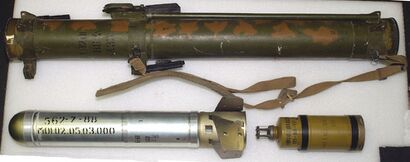
Following FAEs developed by the United States for use in the Vietnam War,[29] Soviet Union scientists quickly developed their own FAE weapons. Since Afghanistan, research and development has continued, and Russian forces now field a wide array of third-generation FAE warheads,[35] such as the RPO-A.[36][37] The Russian armed forces have developed thermobaric ammunition variants for several of their weapons, such as the TBG-7V thermobaric grenade with a lethality radius of 10 m (33 ft), which can be launched from a rocket propelled grenade (RPG) RPG-7. The GM-94 is a 43 mm (1.7 in) pump-action grenade launcher designed mainly to fire thermobaric grenades for close combat. The grenade weighed 250 g (8.8 oz) and contained 160 g (5.6 oz) of explosive, its lethality radius is 3 m (9.8 ft), but due to the deliberate "fragmentation-free" design of the grenade, a distance of 4 m (13 ft) is considered safe.[38]
The RPO-A and upgraded RPO-M are infantry-portable rocket propelled grenades (RPGs), designed to fire thermobaric rockets. The RPO-M, for instance, has a thermobaric warhead with a TNT equivalence of 5.5 kg (12 lb) and destructive capabilities similar to a 152 mm (6 in) high-explosive fragmentation artillery shell.[39][40] The RShG-1 and the RShG-2 are thermobaric variants of the RPG-27 and RPG-26 respectively. The RShG-1 is the more powerful variant, with its warhead having a 10-متر (33 ft) lethality radius and producing about the same effect as 6 kg (13 lb) of TNT.[41] The RMG is a further derivative of the RPG-26 that uses a tandem-charge warhead, with the precursor high-explosive anti-tank (HEAT) warhead blasting an opening for the main thermobaric charge to enter and detonate inside.[42] The RMG's precursor HEAT warhead can penetrate 300 mm of reinforced concrete or over 100 mm of rolled homogeneous armour, thus allowing the 105 mm (4.1 in)-diameter thermobaric warhead to detonate inside.[43]
Other examples include the semi-automatic command to line of sight (SACLOS) or millimeter-wave active radar homing guided thermobaric variants of the 9M123 Khrizantema, the 9M133F-1 thermobaric warhead variant of the 9M133 Kornet, and the 9M131F thermobaric warhead variant of the 9K115-2 Metis-M, all of which are anti-tank missiles. The Kornet has since been upgraded to the Kornet-EM, and its thermobaric variant has a maximum range of 10 km (6 mi) and has a TNT equivalence of 7 kg (15 lb).[44] The 300 mm (12 in) 9M55S thermobaric cluster warhead rocket was built to be fired from the BM-30 Smerch MLRS. A dedicated carrier of thermobaric weapons is the purpose-built TOS-1, a 24-tube MLRS designed to fire 220 mm (8.7 in) thermobaric rockets. A full salvo from the TOS-1 will cover a rectangle 200 في 400 m (220 في 440 yd).[45] The Iskander-M theatre ballistic missile can also carry a 700 kg (1،540 lb) thermobaric warhead.[46]
Many Russian Air Force munitions also have thermobaric variants. The 80 mm (3.1 in) S-8 rocket has the S-8DM and S-8DF thermobaric variants. The S-8's 122 mm (4.8 in) brother, the S-13, has the S-13D and S-13DF thermobaric variants. The S-13DF's warhead weighs only 32 kg (71 lb), but its power is equivalent to 40 kg (88 lb) of TNT. The KAB-500-OD variant of the KAB-500KR has a 250 kg (550 lb) thermobaric warhead. The ODAB-500PM and ODAB-500PMV[47] unguided bombs carry a 190 kg (420 lb) fuel–air explosive each. The KAB-1500S GLONASS/GPS guided 1،500 kg (3،300 lb) bomb also has a thermobaric variant. Its fireball will cover a 150 m (490 ft) radius and its lethal zone is a 500 m (1،600 ft) radius.[48] The 9M120 Ataka-V and the 9K114 Shturm ATGMs both have thermobaric variants.
In September 2007, Russia exploded the largest thermobaric weapon ever made, and claimed that its yield was equivalent to that of a nuclear weapon.[49][50] Russia named this particular ordnance the "Father of All Bombs" in response to the American-developed Massive Ordnance Air Blast (MOAB) bomb, which has the backronym "Mother of All Bombs" and once held the title of the most powerful non-nuclear weapon in history.[51]
العراق
يُزعم أن العراق يمتلك هذه التكنولوجيا منذ عام 1990.[52]
إسرائيل
يُزعم أن إسرائيل تمتلك هذه التكنولوجيا منذ أوائل 1990.[52]
إسپانيا
In 1983, a program of military research was launched with collaboration between the Spanish Ministry of Defence (Directorate General of Armament and Material, DGAM) and Explosivos Alaveses (EXPAL) which was a subsidiary of Unión Explosivos Río Tinto (ERT). The goal of the programme was to develop a thermobaric bomb, the BEAC (Bomba Explosiva de Aire-Combustible).[52] A prototype was tested successfully in a foreign location out of safety and confidentiality concerns.[53] The Spanish Air and Space Force has an undetermined number of BEACs in its inventory.[54]
الصين
In 1996, the People's Liberation Army (PLA) began development of the PF-97, a portable thermobaric rocket launcher, based on the Soviet RPO-A Shmel. Introduced in 2000 it is reported to weigh 3.5 kg and contains 2.1 kg of thermobaric filler. An improved version called the PF-97A was introduced in 2008.[55]
China is reported to have other thermobaric weapons, including bombs, grenades and rockets.[56] Research continues on thermobaric weapons capable of reaching 2,500 degrees.[57][محل شك]
البرازيل
In 2004, under request of EMAER (Estado Maior da Aeronáutica - Military Staff of Aeronautics) and DIRMAB (Diretoria de Material Aeronáutico e Bélico - Board of Aeronautical and Military Equipment) the IAE (Instituto de Aeronautica e Espaço - Institute of Aeronautics and Space) started developing a Thermobaric project called Trocano .
Trocano (tɾoˈkɐnu) is a thermobaric weapon similar in design to the United States' MOAB weapon or Russia's FOAB. Like the US weapon, the Trocano was designed to be pallet-loaded into a C-130 Hercules - "Hércules" (ˈɛʁkuleʃ) - aircraft, and deployed using a parachute to drag it from the C-130's cargo bay and separate from its pallet, at which point the bomb's own aerodynamics determine its drop trajectory.[58]
المملكة المتحدة
In 2009, the British Ministry of Defence (MoD) acknowledged that Army Air Corps (AAC) AgustaWestland Apaches had used AGM-114 Hellfire missiles purchased from the United States against Taliban forces in Afghanistan. The MoD stated that 20 missiles, described as "blast fragmentation warheads", were used in 2008 and a further 20 in 2009. MoD officials told Guardian journalist Richard Norton-Taylor that the missiles were "particularly designed to take down structures and kill everyone in the buildings", as AAC AgustaWestland Apaches were previously equipped with weapon systems deemed ineffective to combat the Taliban. The MoD also stated that "British pilots' rules of engagement were strict and everything a pilot sees from the cockpit is recorded."[59]
In 2018, the MoD accidentally divulged the details of General Atomics MQ-9 Reapers utilised by the Royal Air Force (RAF) during the Syrian civil war, which revealed that the drones were equipped with AGM-114 Hellfire missiles. The MoD had sent a report to a British publication, Drone Wars, in response to a freedom of information request.[60] In the report, it was stated that AGM-114N Hellfire missiles which contained a thermobaric warhead were used by RAF attack drones in Syria. [61][62]
الهند
Based on the high-explosive squash head (HESH) round, a 120 mm thermobaric round was developed in the 2010s by the Indian Ministry of Defence. This HESH round packs thermobaric explosives into the tank shells to increase the effectiveness against enemy bunkers and light armoured vehicles.[63]
The design and the development of the round was taken up by Armament Research and Development Establishment (ARDE). The rounds were designed for the Arjun MBT. The TB rounds contains fuel rich explosive composition called thermobaric explosive. As the name implies, the shells, when they hit a target, produce blast overpressure and heat energy for hundreds of milliseconds. The overpressure and heat causes damage to enemy fortified structures like bunkers and buildings and for soft targets like enemy personnel and light armoured vehicles.[64][65]
صربيا
The company BALKAN NOVOTEH Ltd, formed in 2011, provides the Thermobaric hand grenade TG-1 to the market.[66]
أوكرانيا
In 2017 Ukroboronprom's Scientific Research Institute for Chemical Products in conjunction with Artem State Enterprise (aka Artem Holding Company) announced to the market its new product, the RGT-27S. These can be combined with the RPV-16 grenade launcher, a demonstration of which was witnessed by Oleksandr Turchynov. The grenades, of approximately 600 grams, "create a two second fire cloud with a volume of not less than 13 m³, inside of which the temperature reaches 2,500 degrees. This temperature allows not only for the destruction of the enemy, but are also able to disable lightly armored vehicles."[67][68] The firm showed them at the Azerbaijan International Defense Exhibition in 2018.[69]
التاريخ
محاولات الحظر
Mexico, Switzerland and Sweden presented in 1980 a joint motion to the United Nations to prohibit the use of thermobaric weapons, to no avail.[52]
United Nations Institute for Disarmament Research categorizes these weapons as "enhanced blast weapons" and there was pressure to regulate these around 2010, again to no avail.[70]
الاستخدام العسكري
الولايات المتحدة

FAEs such as first-generation CBU-55 fuel-air weapons saw extensive use in the Vietnam War.[30] A second generation of FAE weapons were based on those, and were used by the United States in Iraq during Operation Desert Storm.[71] A total of 254 CBU-72s were dropped by the United States Marine Corps, mostly from A-6Es. They were targeted against mine fields and personnel in trenches, but were more useful as a psychological weapon.
The US military also used thermobaric weapons in Afghanistan. On 3 March 2002, a single 2،000 lb (910 kg) laser guided thermobaric bomb was used by the United States Air Force against cave complexes in which Al-Qaeda and Taliban fighters had taken refuge in the Gardez region of Afghanistan.[72][73] The SMAW-NE was used by the US Marines during the First Battle of Fallujah and the Second Battle of Fallujah.
The AGM-114N Hellfire II was first used by US forces in 2003 in Iraq.[74]
الاتحاد السوڤيتي
FAEs were reportedly used against China in the 1969 Sino-Soviet border conflict.[75][27]
The TOS-1 system was test fired in Panjshir Valley during the Soviet–Afghan War in the late 1980s.[76] MiG-27 attack aircraft of the 134th APIB also used ODAB-500S/P fuel-air bombs against Mujahideen forces in Afghanistan, but they were found to be unreliable and dangerous to ground crew.[77]
روسيا
Russian military forces reportedly used ground-delivered thermobaric weapons during the Battle for Grozny (first and second Chechen Wars) to attack dug-in Chechen fighters. The use of TOS-1 heavy MLRS and "RPO-A Shmel" shoulder-fired rocket system during the Chechen Wars is reported to have occurred.[78] Russia used the RPO-A Shmel in the First Battle of Grozny, whereupon it was designated as a very useful round.[37]
It was thought that, during the September 2004 Beslan school hostage crisis, a multitude of handheld thermobaric weapons were used by the Russian Armed Forces in their efforts to retake the school. The RPO-A and either the TGB-7V thermobaric rocket from the RPG-7 or rockets from either the RShG-1 or the RShG-2 is claimed to have been used by the Spetsnaz during the initial storming of the school.[79][80][81] At least three and as many as nine RPO-A casings were later found at the positions of the Spetsnaz.[82][83] In July 2005 the Russian government admitted to the use of the RPO-A during the crisis.[84]
During the 2022 Russian invasion of Ukraine, CNN reported that Russian forces were moving thermobaric weapons into Ukraine.[85][86] On 28 February 2022, Ukraine's ambassador to the United States accused Russia of deploying a thermobaric bomb.[87][88]
المملكة المتحدة
During the War in Afghanistan, British forces, including the Army Air Corps and Royal Air Force, used thermobaric AGM-114N Hellfire missiles against the Taliban.[89] In the Syrian civil war, British military drones also used AGM-114N Hellfire missiles; in the first three months of 2018, British drones fired 92 Hellfire missiles in Syria.[90]
سوريا
تزعم تقارير المقاتلين المتمردين من الجيش السوري الحر أن القوات الجوية السورية استخدمت مثل هذه الأسلحة ضد أهداف في المناطق السكنية التي يحتلها المقاتلون المتمردون، كما حدث أثناء معركة حلب[91] وفي كفر بطنا.[92] بينما يزعم آخرون أن القوات السورية استتخدمت القنبلة الروسية ODAB-500PM في أعزاز.[93] إحدى لجان محققي الأمم المتحدة لحقوق الإنسان أن الحكومة السورية استخدمت القنابل الحرارية ضد بلدة القصير المتمردة في مارس 2013.[94]
The Russia and Syrian governments have used thermobaric bombs and other thermobaric munitions during the Syrian civil war against insurgents and insurgent-held civilian areas.[95][93][96]
أوكرانيا
In March 2023 soldiers from the 59th Motorized Brigade of Ukraine showed off the destruction by a thermobaric RGT-27S2 hand grenade delivered by Mavic 3 drone of a derelict Russian infantry fighting vehicle.[97]
استخدامات تنظيمات أخرى
Thermobaric and fuel–air explosives have been used in guerrilla warfare since the 1983 Beirut barracks bombing in Lebanon, which used a gas-enhanced explosive mechanism that was probably propane, butane, or acetylene.[98] The explosive used by the bombers in the US 1993 World Trade Center bombing incorporated the FAE principle by using three tanks of bottled hydrogen gas to enhance the blast.[99][100]
Jemaah Islamiyah bombers used a shock-dispersed solid fuel charge,[101] based on the thermobaric principle,[102] to attack the Sari nightclub during the 2002 Bali bombings.[103]
القانون الدولي
International law does not prohibit the use of thermobaric munitions, fuel-air explosive devices, or vacuum bombs against military targets.[104][27] Their use against civilian populations or infrastructure may be banned by the United Nations (UN) Convention on Certain Conventional Weapons (CCW),[105] specifically the Protocol on Incendiary Weapons. اعتبارا من نوفمبر 2022[تحديث], all past attempts to regulate or restrict thermobaric weapons have failed.[106][27]
في الثقافة العامة
In the 1995 film Outbreak a thermobaric weapon (which they refer to as a fuel air bomb) is used to destroy an African village to keep the perfect biological weapon (a virus) a secret, and later nearly used to wipe out a US town to keep the original virus intact.
انظر أيضاً
المصادر
- ^ Harrison, Virginia (2022-03-01). "What are thermobaric weapons and how do they work?". The Guardian (in الإنجليزية). Archived from the original on 2022-03-01. Retrieved 2022-03-01.
- ^ Türker, Lemi (2016). "Thermobaric and enhanced blast explosives (TBX and EBX)". Defence Technology. 12 (6): 423–445. doi:10.1016/j.dt.2016.09.002. S2CID 138647940.
- ^ Klapötke, Thomas M. (2022). Chemistry of High-Energy Materials. doi:10.1515/9783110739503. ISBN 9783110739503.
- ^ أ ب Parsons, Jeff (2 March 2022). "What is a thermobaric weapon? Putin accused of using devastating 'vacuum bomb' in Ukraine". Metro.
- ^ Yen, Ng Hsiao; Wang, Lee Yiew (2012). "Reactive Metals in Explosives". Propellants, Explosives, Pyrotechnics. 37 (2): 143–155. doi:10.1002/prep.200900050.
- ^ Trzciński, Waldemar A.; Maiz, Lotfi (2015). "Thermobaric and Enhanced Blast Explosives - Properties and Testing Methods". Propellants, Explosives, Pyrotechnics. 40 (5): 632–644. doi:10.1002/prep.201400281.
- ^ "Libye – l'Otan utilise une bombe FAE | Politique, Algérie" (in الفرنسية). Algeria ISP. 18 October 2011. Archived from the original on 20 June 2012. Retrieved 23 April 2013.
- ^ Türker, Lemi (2016-12-01). "Thermobaric and enhanced blast explosives (TBX and EBX)". Defence Technology (in الإنجليزية). 12 (6): 423–445. doi:10.1016/j.dt.2016.09.002. ISSN 2214-9147. S2CID 138647940.
- ^ Lester W. Grau and Timothy Smith, A 'Crushing' Victory: Fuel-Air Explosives and Grozny 2000, August 2000
- ^ "Ukraine conflict: What is a vacuum or thermobaric bomb?". BBC News. 2 March 2022. Archived from the original on 1 March 2022. Retrieved 2 March 2022.
- ^ Nettleton, J. Occ. Accidents, 1, 149 (1976).
- ^ Strehlow, 14th. Symp. (Int.) Comb. 1189, Comb. Inst. (1973).
- ^ Brousseau, Patrick; Anderson, C. John (2002). "Nanometric Aluminum in Explosives". Propellants, Explosives, Pyrotechnics. 27 (5): 300–306. doi:10.1002/1521-4087(200211)27:5<300::AID-PREP300>3.0.CO;2-#.
- ^ See Nanofuel/Oxidizers For Energetic Compositions – John D. Sullivan and Charles N. Kingery (1994) High explosive disseminator for a high explosive air bomb[dead link]
- ^ Slavica Terzić, Mirjana Dakić Kolundžija, Milovan Azdejković and Gorgi Minov (2004) Compatibility Of Thermobaric Mixtures Based On Isopropyl Nitrate And Metal Powders Archived 2012-03-02 at the Wayback Machine.
- ^ Meyer, Rudolf; Josef Köhler; Axel Homburg (2007). Explosives. Weinheim: Wiley-VCH. pp. 312. ISBN 978-3-527-31656-4. OCLC 165404124.
- ^ Nettleton, arch. combust. 1,131, (1981). 1,131، (1981).
- ^ Stephen B. Murray Fundamental and Applied Studies of Fuel-Air Detonation Archived 2010-01-19 at the Wayback Machine.
- ^ Nettleton, Comb. and Flame, 24,65 (1975).
- ^ Fire Prev. Sci. and Tech. No. 19,4 (1976)
- ^ May L.Chan (2001) Advanced Thermobaric Explosive Compositions.
- ^ New Thermobaric Materials and Weapon Concepts Archived 2014-05-18 at the Wayback Machine.
- ^ Anna E. Wildegger-Gaissmaier (April 2003). "Aspects of thermobaric weaponry" (PDF). ADF Health. 4: 3–6. S2CID 189802993.
- ^ أ ب "Backgrounder on Russian Fuel Air Explosives ("Vacuum Bombs") | Human Rights Watch". Hrw.org. 1 February 2000. Archived from the original on 10 February 2013. Retrieved 23 April 2013.
- ^ Defense Intelligence Agency, "Future Threat to the Soldier System, Volume I; Dismounted Soldier – Middle East Threat", September 1993, p. 73.
- ^ "Main Types of Artillery Ammunition in 1914-1918". passioncompassion1418. Retrieved 1 April 2022.
- ^ أ ب ت ث Hanson, Marianne (2 March 2022). "What are thermobaric weapons? And why should they be banned?". The Conversation. Retrieved 2 November 2022.
- ^ Karlsch, Rainer (24 September 2007). "Massenvernichtungswaffe: Großvaters Vakuumbombe" [Weapon of Mass Destruction: Grandfather's Vacuum Bomb]. Faz.net (in الألمانية). Archived from the original on 2020-08-11. Retrieved 2020-06-03.
- ^ أ ب Andrew, D (1 May 2003). "Munitions – Thermobaric Munitions and their Medical Effects!". Australian Military Medicine: 9–12. Archived from the original on 27 February 2022. Retrieved 1 March 2022.
- ^ أ ب "Fuel Air Explosive (FAE) systems" (PDF). TNMA. Technical Note 09.30 /04 (Version 1): 2. 1 July 2013. Archived from the original (PDF) on 25 March 2022. Retrieved 25 March 2022.
- ^ Hambling, David. "Thermobaric Grenade Brings Down the House? (Updated)". Wired. Archived from the original on 9 March 2023. Retrieved 23 September 2023.
- ^ David Hambling (2005) "Marines Quiet About Brutal New Weapon" Archived 2015-02-08 at the Wayback Machine
- ^ "HELLFIRE Thermobaric Warhead Approved for Production". www.lockheedmartin.com (in الإنجليزية). 2022. Retrieved 2022-03-05.
- ^ Guest, Tim (10 November 2022). "Thermobarics – Developments and Deployments". European Security & Defence. Archived from the original on 24 March 2023. Retrieved 23 September 2023.
- ^ "Backgrounder on Russian Fuel Air Explosives ('Vacuum Bombs')". Human Rights Watch. 27 December 2008. Archived from the original on 15 January 2009. Retrieved 30 July 2009.
- ^ Kolev, Stefan K.; Tsonev, Tsvetomir T. (2022). "Aluminized Enhanced Blast Explosive Based on Polysiloxane Binder". Propellants, Explosives, Pyrotechnics. 47 (2). doi:10.1002/prep.202100195. S2CID 244902961.
- ^ أ ب Lester W. Grau and Timothy L. Thomas (Marine Corps Gazette, April 2000) "Russian Lessons Learned From the Battles For Grozny" Archived 2010-04-30 at the Wayback Machine
- ^ "Modern Firearms – GM-94". Russia: World Guns. 24 January 2011. Archived from the original on 7 November 2016. Retrieved 12 July 2011.
- ^ "New RPO Shmel-M Infantry Rocket Flamethrower Man-Packable Thermobaric Weapon". defensereview.com. 19 July 2006. Archived from the original on 27 October 2014. Retrieved 27 August 2012.
- ^ "Shmel-M: Infantry Rocket-assisted Flamethrower of Enhanced Range and Lethality". Kbptula.ru. Archived from the original on 29 December 2013. Retrieved 28 December 2013.
- ^ "Modern Firearms – RShG-1". Russia: World Guns. 24 January 2011. Archived from the original on 31 October 2012. Retrieved 12 July 2011.
- ^ "Modern Firearms – RMG". Russia: World Guns. 24 January 2011. Archived from the original on 17 August 2011. Retrieved 12 July 2011.
- ^ "RMG – A new Multi-Purpose Assault Weapon from Bazalt". defense-update.com. 9 November 2008. Archived from the original on 13 July 2012. Retrieved 27 August 2012.
- ^ "Kornet-EM: Multi-purpose Long-range Missile System". Russia: Kbptula. Archived from the original on 29 December 2013. Retrieved 28 December 2013.
- ^ "TOS-1 Heavy flamethrower system". military-today.com. Archived from the original on 10 October 2012. Retrieved 27 August 2012.
- ^ "SS-26". Missilethreat.csis.org. Archived from the original on 5 January 2017. Retrieved 28 December 2013.
- ^ "ODAB-500PMV Fuel-Air-Explosive bomb". Rosoboronexport. Archived from the original on 2019-08-29. Retrieved 2019-09-03.
- ^ Air Power Australia (4 July 2007). "How to Destroy the Australian Defence Force". Ausairpower.net. Archived from the original on 11 June 2011. Retrieved 12 July 2011.
- ^ "Russia unveils devastating vacuum bomb". ABC News. 2007. Archived from the original on 30 December 2010. Retrieved 12 September 2007.
- ^ "Video of test explosion". BBC News. 2007. Archived from the original on 2 February 2009. Retrieved 12 September 2007.
- ^ Harding, Luke (12 September 2007). "Russia unveils the father of all bombs". The Guardian. London. Archived from the original on 16 October 2019. Retrieved 12 September 2007.
- ^ أ ب ت ث "Serra no descarta que España tenga bombas de aire-combustible" (in الإسبانية). EDICIONES EL PAÍS. 11 October 1990.
- ^ "Pilotos españoles probation la Superbomba Aire-Combustible en un país extranjero, p. 23 – ABC.es". hemeroteca.abc.es (in الإسبانية). 22 October 1990. Archived from the original on 19 August 2016.
- ^ Aguilar, Juan (9 February 2014). "¿Dispone España de armas estratégicas?". www.elespiadigital.com (in الإسبانية). Archived from the original on 27 July 2016.
- ^ "PF-97 Thermobaric rocket launcher". Military Today. Retrieved 2 April 2022.
- ^ Lopez, Eddie (8 August 2018). "WILL THERMOBARIC WEAPONS OVERWHELM THE MILITARY HEALTH SYSTEM?". War Room - US Army War College. Retrieved 14 March 2022.
- ^ "Better than laser?China's thermobaric bomb reaches 2500 degrees high temperature, once exported, the United States will be miserable?". INEWS. Retrieved 14 March 2022.
- ^ http://www.iae.cta.br/Arquivos/Relatorio_de_atividades_2011.pdf%7Ctitle=Relatorio[dead link] de atividades 2011|trans-title=2011 Activities Report|publisher=Instituto de Aeronáutica e Espaço [Brazilian Aeronautics and Space Institute]|accessdate=20 November 2015
- ^ Norton-Taylor, Richard (28 May 2009). "MoD admits use of controversial 'enhanced blast' weapons in Afghanistan". The Guardian. Retrieved 9 November 2022.
- ^ Kay, Linda (3 May 2018). "UK Troops Using Deadly 'Thermobaric' Weapons In Syrian Civil War: Report". Defense World. Retrieved 9 November 2022.
- ^ Cole, Chris (3 May 2018). "MoD accidentally reveals British drones firing thermobaric missiles in Syria". Defense World. Retrieved 9 November 2022.
- ^ Kay, Linda (2 May 2018). "UK Troops Using Deadly 'Thermobaric' Weapons In Syrian Civil War: Report". Drone Wars. Retrieved 9 November 2022.
- ^ "120 mm Thermobaric (TB) Ammunition For MBT Arjun | Defence Research and Development Organisation – DRDO, Ministry of Defence, Government of India". www.drdo.gov.in. Archived from the original on 2021-05-26. Retrieved 2021-05-26.
- ^ "120 mm Penetration Cum Blast (PCB) and Thermobaric (TB) Ammunition For MBT Arjun | Defence Research and Development Organisation - DRDO, Ministry of Defence, Government of India". www.drdo.gov.in. Archived from the original on 26 May 2021.
- ^ "Fire-power of DRDO's Arjun Tank takes quantum jump with new ammunition: MoD". The Economic Times. Archived from the original on 2018-08-05. Retrieved 2021-09-23.
- ^ "THERMOBARIC HAND GRENADE TG-1". BALKAN NOVOTEH Ltd. Retrieved 22 March 2023.
- ^ "Ukraine developed a new thermobaric weapon". UAWire. 29 July 2017.
- ^ "Ukrainian Defense Review". No. #4. Defense Express. October–December 2017. p. 32.
{{cite news}}: CS1 maint: date format (link) - ^ Gyűrösi, Miroslav (December 2018). "ADEX-2018 cz. 2". ZESPÓŁ BADAŃ I ANALIZ MILITARNYCH SP. Z O.O.
- ^ Brehm, Maya (2010). "Protecting Civilians from the Effects of Explosive Weapons An Analysis of International Legal and Policy Standards" (PDF). United Nations Institute for Disarmament Research.
- ^ CBU-72 / BLU-73/B Fuel/Air Explosive (FAE) - Dumb Bombs
- ^ "US Uses Bunker-Busting 'Thermobaric' Bomb for First Time". Commondreams.org. 3 March 2002. Archived from the original on 12 January 2010. Retrieved 23 April 2013.
- ^ Franchi, Peter La (22 December 2003). "China starts on thermobaric bomb". Flight Global (in الإنجليزية). Retrieved 23 September 2023.
- ^ "New Missiles Floored Enemy In Iraq - CBS News". www.cbsnews.com. Associated Press. 14 May 2003. Archived from the original on 1 March 2022. Retrieved 23 September 2023.
- ^ "Fact Sheet: Russia's Use of Thermobaric Weapons in Ukraine". Center for Arms Control and Non-Proliferation. March 2022. Retrieved 25 March 2022.
- ^ Swearingen, Jake (14 September 2015). "This Russian Tank-Mounted Rocket Launcher Can Incinerate 8 City Blocks". Popular Mechanics. Archived from the original on 27 February 2018. Retrieved 1 April 2018.
- ^ Gordon, E. (2019). Mikoyan MiG-23 and MiG-27. Dmitriĭ Komissarov. Manchester. p. 369. ISBN 978-1-910809-31-0. OCLC 1108690733. Archived from the original on 2022-03-02. Retrieved 2021-10-24.
{{cite book}}: CS1 maint: location missing publisher (link) - ^ "Foreign Military Studies Office Publications – A 'Crushing' Victory: Fuel-Air Explosives and Grozny 2000". Fmso.leavenworth.army.mil. Archived from the original on 8 May 2013. Retrieved 23 April 2013.
- ^ "Russian forces faulted in Beslan school tragedy". Christian Science Monitor. 1 September 2006. Archived from the original on 6 September 2006. Retrieved 14 February 2007.
- ^ Russia: Independent Beslan Investigation Sparks Controversy Archived 2006-08-29 at the Wayback Machine, The Jamestown Foundation, 29 August 2006
- ^ Beslan still a raw nerve for Russia Archived 2012-05-20 at the Wayback Machine, BBC News, 1 September 2006
- ^ ACHING TO KNOW Archived 2011-06-24 at the Wayback Machine, Los Angeles Times, 27 August 2005
- ^ Searching for Traces of "Shmel" in Beslan School Archived 2009-01-03 at the Wayback Machine, Kommersant, 12 September 2005
- ^ A Reversal Over Beslan Only Fuels Speculation Archived 2011-09-03 at the Wayback Machine, The Moscow Times, 21 July 2005
- ^ Zitser, Joshua. "Russian army deploys its TOS-1 heavy flamethrower capable of vaporizing human bodies near Ukrainian border, footage shows". Business Insider Africa. Archived from the original on 27 February 2022. Retrieved 27 February 2022.
- ^ "What are thermobaric weapons?" (in الإنجليزية الأسترالية). ABC News. 2022-02-27. Archived from the original on 2022-02-27. Retrieved 2022-02-27.
- ^ "Oil depot burns after artillery shelling in Okhtyrka, Sumy Oblast". Kyiv Independent. 2022-02-28. Archived from the original on 2022-03-02. Retrieved 2022-02-28 – via Twitter.
Mayor Pavlo Kuzmenko reported that Russian occupiers dropped a vacuum bomb.
- ^ Zengerle, Patricia (2022-03-01). "Ukraine envoy to U.S. says Russia used a vacuum bomb in its invasion". Reuters (in الإنجليزية). Archived from the original on 2022-03-01. Retrieved 2022-03-01.
- ^ Norton-Taylor, Richard (28 May 2009). "MoD admits use of controversial 'enhanced blast' weapons in Afghanistan". The Guardian. Retrieved 9 November 2022.
- ^ Kay, Linda (3 May 2018). "UK Troops Using Deadly 'Thermobaric' Weapons In Syrian Civil War: Report". Defense World. Retrieved 9 November 2022.
- ^ "Syria rebels say Assad using 'mass-killing weapons' in Aleppo". Ynetnews. 10 October 2012. Archived from the original on 12 July 2013. Retrieved 11 November 2012.
- ^ "Dropping Thermobaric Bombs on Residential Areas in Syria_ Nov. 5. 2012". First Post. 11 November 2012. Archived from the original on 10 February 2013. Retrieved 11 November 2012.
- ^ أ ب DeGhett, Torie Rose (28 August 2015). "A New Kind of Bomb Is Being Used in Syria and It's a Humanitarian Nightmare". www.vice.com. Archived from the original on 2021-06-11.
- ^ Cumming-Bruce, Nick (4 June 2013). "U.N. Panel Reports Increasing Brutality by Both Sides in Syria". The New York Times. Archived from the original on 15 April 2017. Retrieved 28 February 2017.
- ^ Ullah, Areeb (22 February 2018). "Eastern Ghouta home of 'Noor and Alaa' destroyed by Syrian bombs". Middle East Eye. Archived from the original on 2021-06-11.
- ^ "Thermobaric Bombs And Other Nightmare Weapons Of The Syrian Civil War". Popular Science. Recurrent. 18 March 2019. Archived from the original on 11 June 2021.
- ^ "The latest military situation of the Russia-Ukraine conflict: Ukraine is open, a grenade blows up a Russian infantry fighting vehicle". IMEDIA. 7 March 2023.
- ^ Richard J. Grunawalt. Hospital Ships In The War On Terror: Sanctuaries or Targets? Archived 2013-04-01 at the Wayback Machine (PDF), Naval War College Review, Winter 2005, pp. 110–11.
- ^ Paul Rogers (2000) "Politics in the Next 50 Years: The Changing Nature of International Conflict" Archived 2019-10-19 at the Wayback Machine
- ^ J. Gilmore Childers; Henry J. DePippo (24 February 1998). "Senate Judiciary Committee, Subcommittee on Technology, Terrorism, and Government Information hearing on "Foreign Terrorists in America: Five Years After the World Trade Center"". Fas. Archived from the original on 16 November 2020. Retrieved 12 July 2011.
- ^ P. Neuwald; H. Reichenbach; A. L. Kuhl (2003). "Shock-Dispersed-Fuel Charges-Combustion in Chambers and Tunnels" (PDF). Archived from the original (PDF) on 2017-02-07. Retrieved 2008-07-19.
- ^ David Eshel (2006). "Is the world facing Thermobaric Terrorism?". Archived from the original on 7 June 2011.
- ^ Wayne Turnbull (2003). "Bali:Preparations". Archived from the original on 2008-03-11. Retrieved 2008-07-19.
- ^ "Ukraine's ambassador to US says Russia used a vacuum bomb, international groups say banned cluster munitions used to strike shelter". Australian Broadcasting Corporation. 1 March 2022. Retrieved 4 March 2022.
- ^ Dunlap, Charlie (27 February 2022). "The Ukraine crisis and the international law of armed conflict (LOAC): some Q & A". Lawfire. Retrieved 4 March 2022.
- ^ Seidel, Jamie (27 February 2022). "Father of all bombs': Russia's brutal weapon". news.com.au. Retrieved 11 March 2022.
وصلات خارجية
 Media related to قنبلة فراغية at Wikimedia Commons
Media related to قنبلة فراغية at Wikimedia Commons
- CS1 الفرنسية-language sources (fr)
- Articles with dead external links from April 2020
- CS1 الألمانية-language sources (de)
- CS1 الإسبانية-language sources (es)
- Articles with dead external links from September 2023
- CS1 maint: date format
- CS1 maint: location missing publisher
- CS1 الإنجليزية الأسترالية-language sources (en-au)
- Short description is different from Wikidata
- Articles with unsourced statements from May 2023
- مقالات ذات عبارات محل شك
- مقالات فيها عبارات متقادمة منذ نوفمبر 2022
- جميع المقالات التي فيها عبارات متقادمة
- قنابل فراغية
- أسلحة متفجرة
- ذخيرة
- أسلحة مضادة للأفراد
